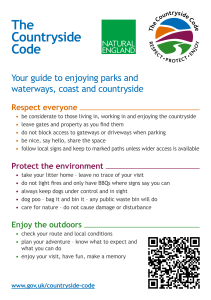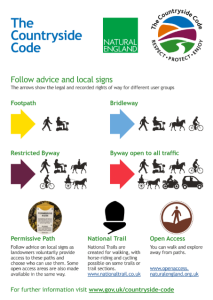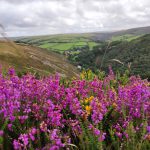There’s nothing quite like being in the great outdoors, whether that be a gentle stroll through the countryside, an invigorating bike ride, or a family camping adventure. Wherever your outdoor antics may take you, it’s important to respect your surroundings by following the Countryside Code.

If you’ve heard of the Countryside Code but are not quite sure what it entails, this handy blog covers the key points, so you can respect, protect, and enjoy the outdoors.
What is the history of the Countryside Code?
The Countryside Code is a set of guidelines for the public across England and Wales to follow when out in rural areas. It was officially introduced in 1951 as part of the National Parks and Access to the Countryside Act 1949 by the National Parks Commission. In 2004, it rebranded as the Countryside Code by the Countryside Agency and Countryside Council for Wales.
Prior to this, a version of the code existed between the 1930s – 1940s by the Ramblers Association entitled ‘The Ramblers Code’ to help preserve natural surroundings. As the code developed during the 1950s, a series of cartoons designed by Normal Thelwell were included in ‘The Country Code’ book to help boost awareness.
Today, the Countryside Code campaign features Shaun the Sheep to help spread the message of protecting rural areas for families and young people and is managed by Natural England and Natural Resources Wales.
What are the Countryside Code rules?
While the wording of the Countryside Code has developed over the years, the general rules remain the same. Here are the key points to remember on all your outdoor adventures.
Respect everyone
Respect is a key rule of the Countryside Code, whether that be towards those who live and work in the area or fellow members of the public who are out enjoying themselves. It’s essential to be mindful of your surroundings at all times. This means:
- Leaving gates and property as you found them.
- Not blocking access to gateways or driveways when parking.
- Be polite to others and share the space.
- Follow signs and marked paths.
- Path users should give way to horse riders.
- Cyclists should give way to pedestrians and horse riders.
Protect the environment
It’s important to always leave areas clean and tidy. Wherever you are, you should always:
- Put your litter in the bin or take it away with you – this includes dog poo!
- Do not start fires and only have BBQs where signs indicate you can.
- Keep dogs under control and in sight.
- Refrain from feeding livestock, horses, or wild animals.
- Care for nature and don’t cause any disturbance.

Enjoy the outdoors
Above all, being in the countryside is all about enjoying the outdoors. To ensure you have the best time possible, remember to:
- Check your route ahead of time and keep an eye on the weather – you’ll want to dress appropriately!
- Plan your trip beforehand to see what’s nearby and make the most of your day.
- Immerse yourself! Being outdoors is great for physical and mental wellbeing, so take in the fresh air and enjoy your surroundings.


Follow advice and signs
When out walking in the countryside, you’ll notice a variety of signs for your attention. It’s important to make note of these as they will help guide you and prepare for the route ahead. Signs are often indicated by different coloured arrows (shown in the diagrams above). Here are some key ones to look out for:
Footpath (yellow arrow)
Public footpaths are indicated by yellow arrows. This means you’re permitted to walk along the route via foot or mobility aid. Be mindful that not all footpaths are necessarily easy-going routes!
Bridleway (blue arrow)
Bridleways (sometimes called bridle paths) are routes that were originally made for horses, so are often wide and have plenty of headroom.
Restricted byway (purple arrow)
Restricted byways are clear of ‘mechanically propelled vehicles’ i.e. cars, vans, and motorbikes. You may occasionally come across a farm vehicle but, for the most part, these routes are safe and allow you to walk uninterrupted.
Byway open to all traffic (BOATs) (red arrow)
These routes allow both pedestrians and cars, vans, and motorbikes. However, these routes aren’t the same as standard roads as they may contain uneven surfaces and gates.
In addition to the coloured arrows, a few other notable signs are as follows:
Permissive path
Permissive paths are routes that are privately owned but the landowner has allowed the public to use. There are sometimes restrictions to individual permissive paths, so double check this before you continue. Bear in mind that the landowner can withdraw access to the path at any time i.e. to move livestock, so pay attention to the signs closely.
National trail
National trails are for long distance walking, cycling or horse riding.
Open access
Open access routes allow you to explore away from paths.

And that covers the essentials of the Countryside Code. By following the above guidance, you’ll get the best possible experience from your outdoor adventures. Adhering to these rules ensures you’re helping protect the environment while being respectful of those around you.
If you’re looking for some outdoor inspiration, check out our blog on Britain’s National Parks, full of amazing destinations to visit during your Spring/Summer getaways.
For all your outdoor needs from camping essentials to cycling gear, you’ll find everything you need on halfords.com.
